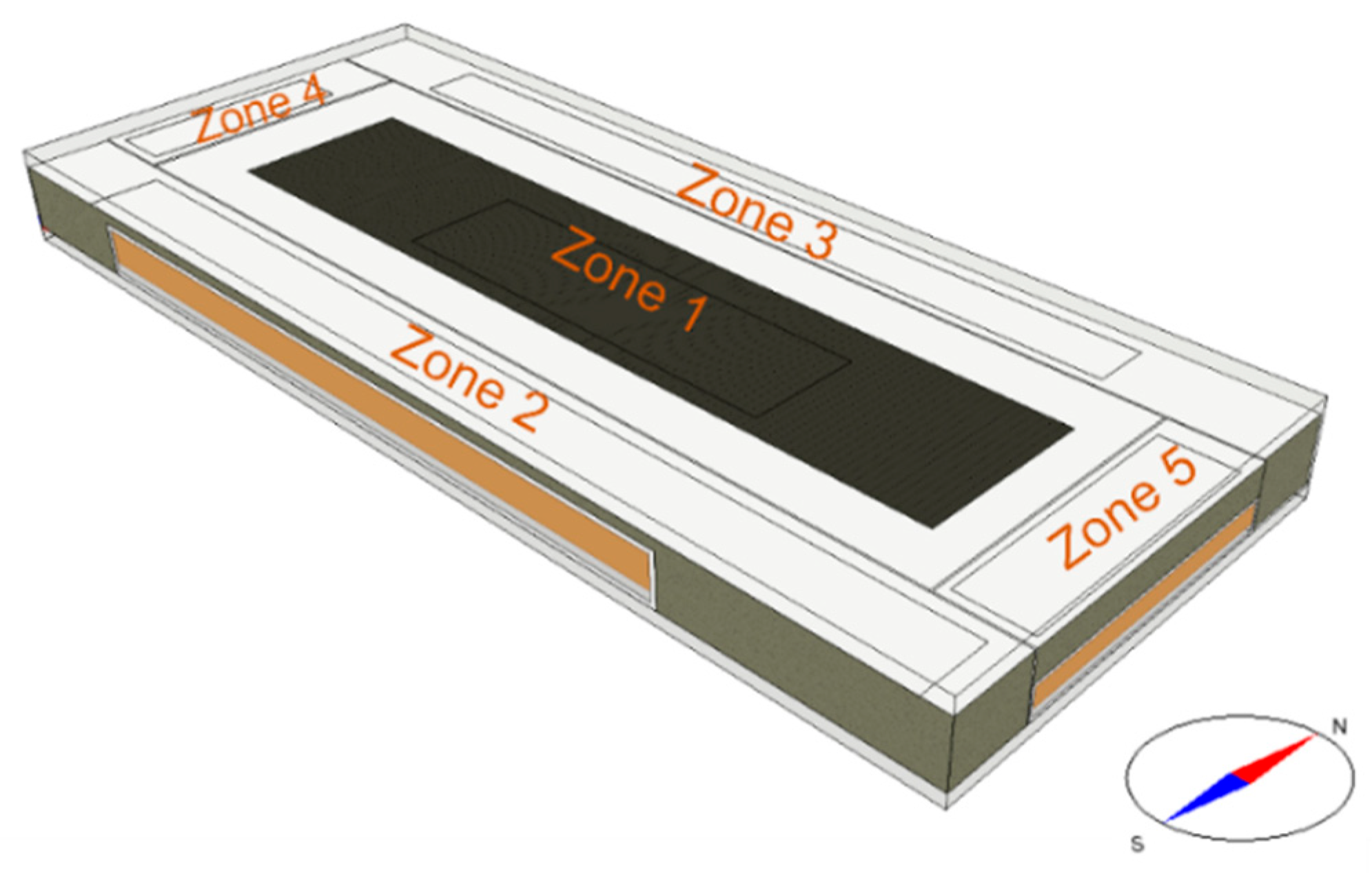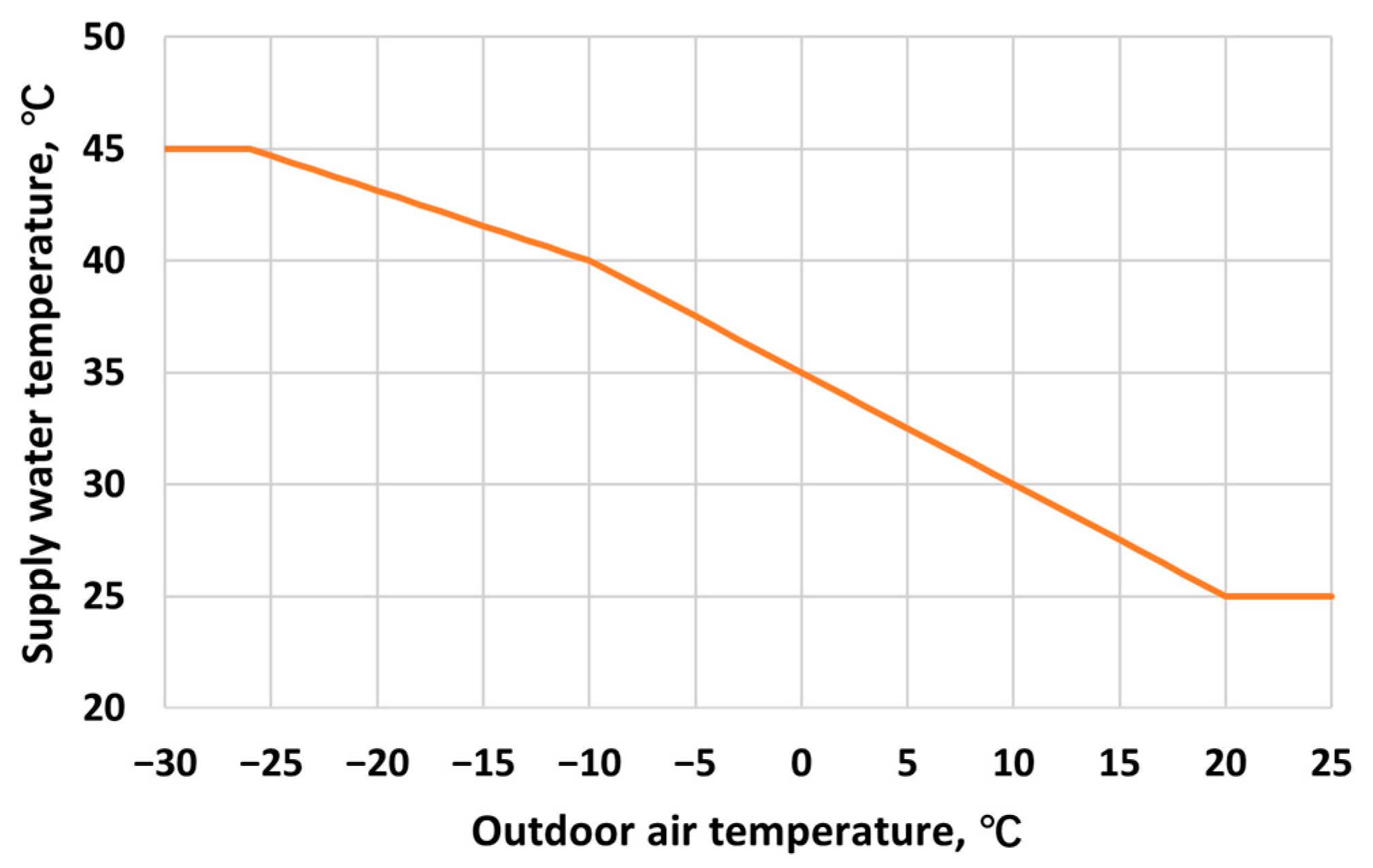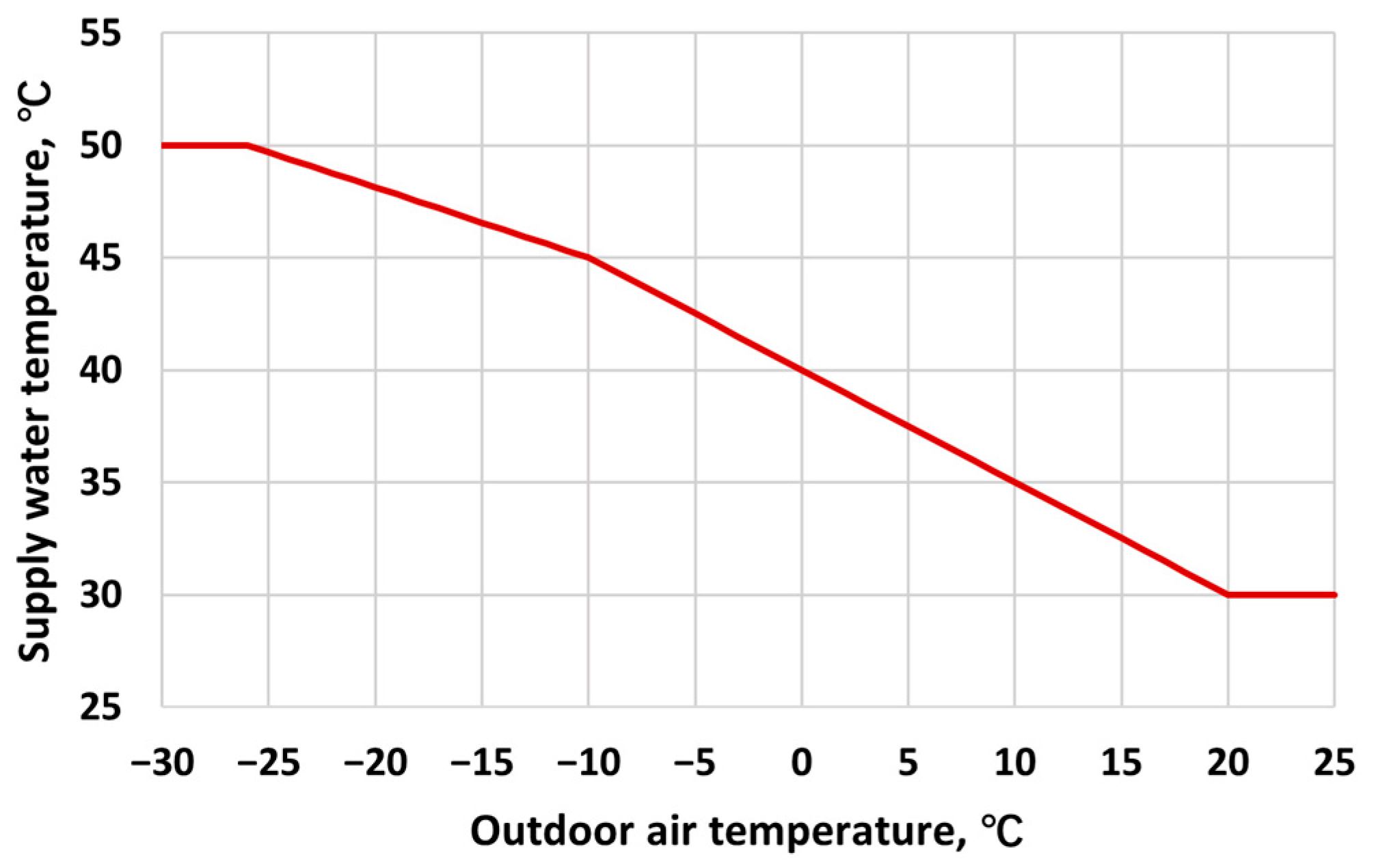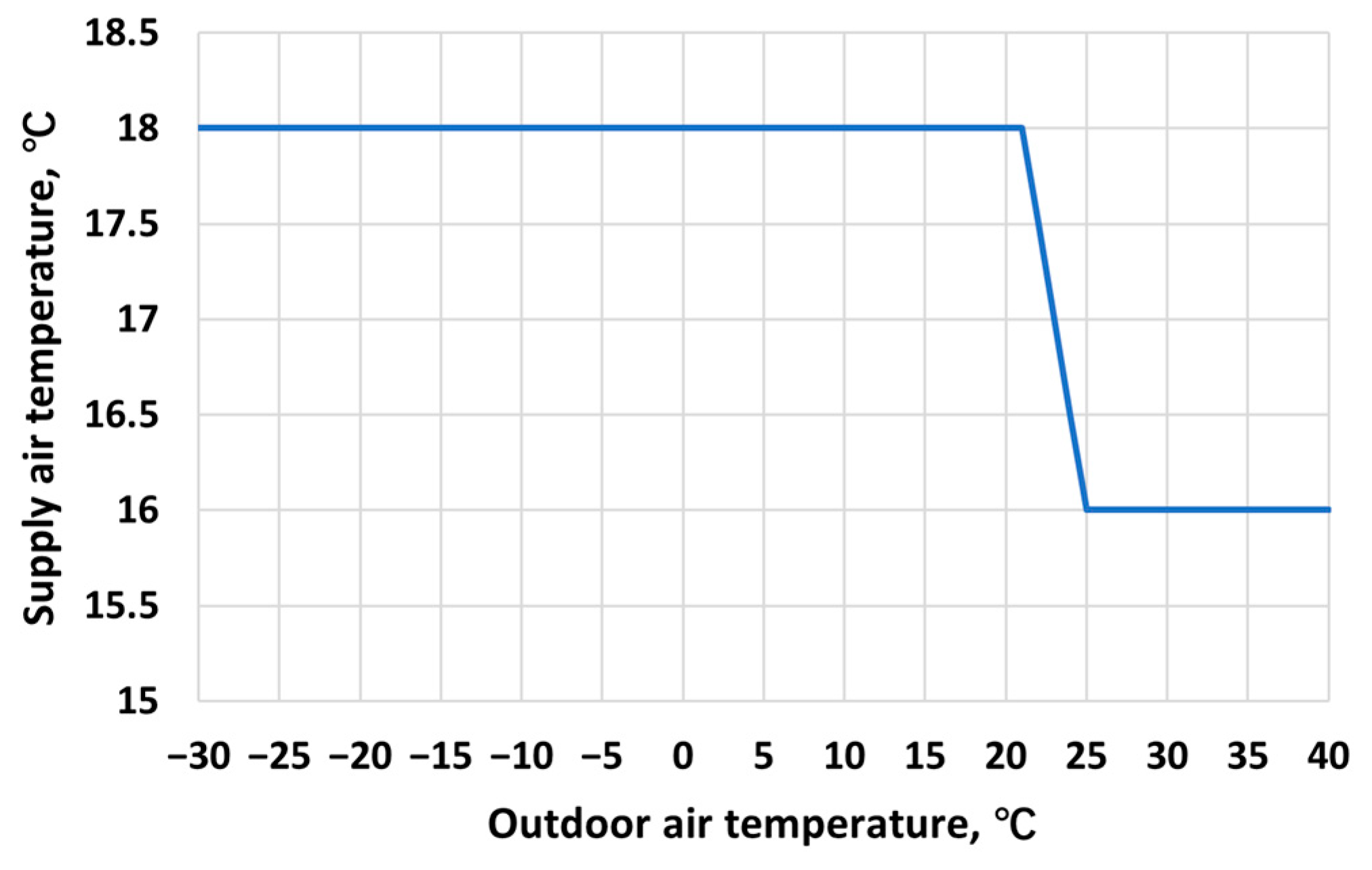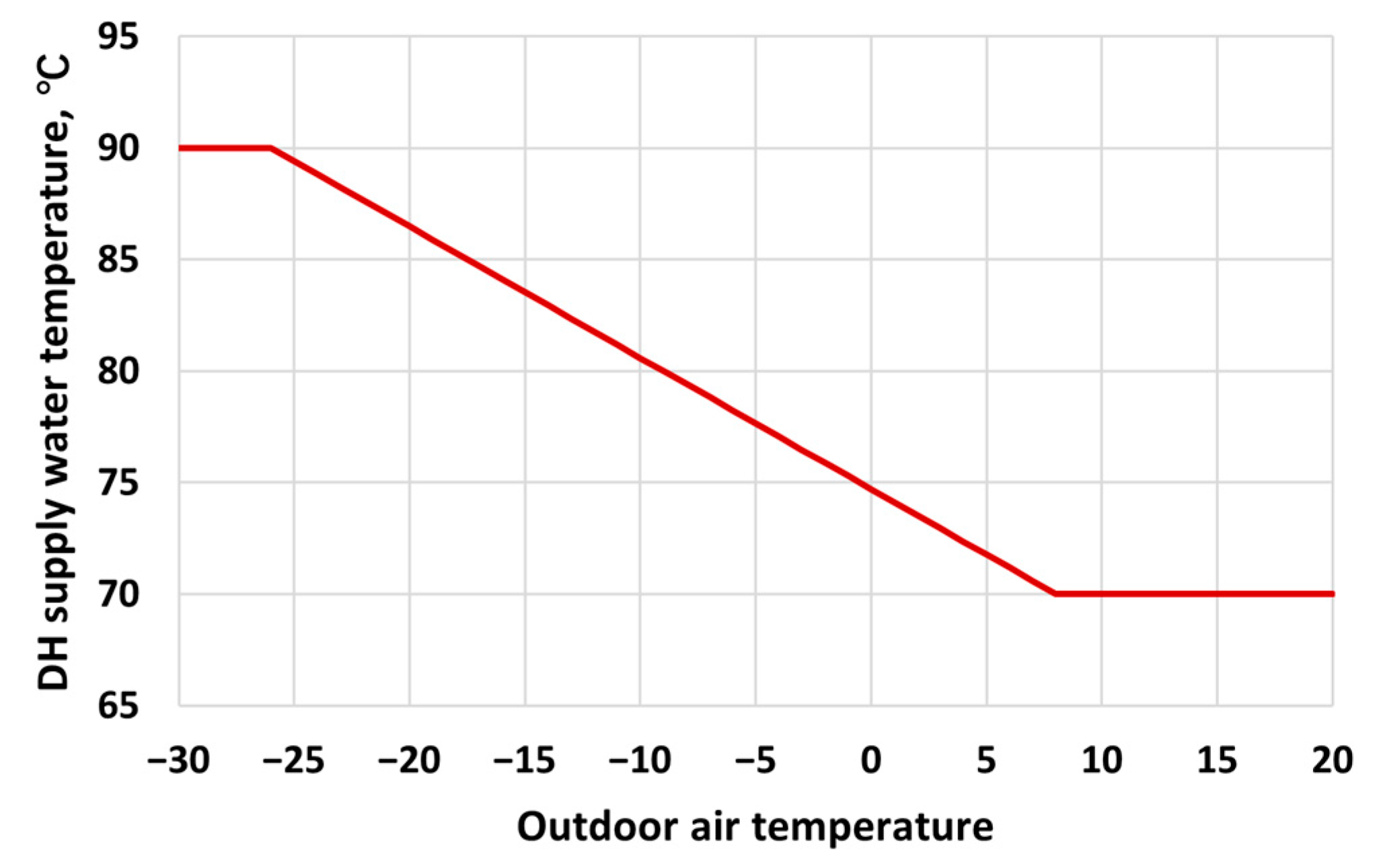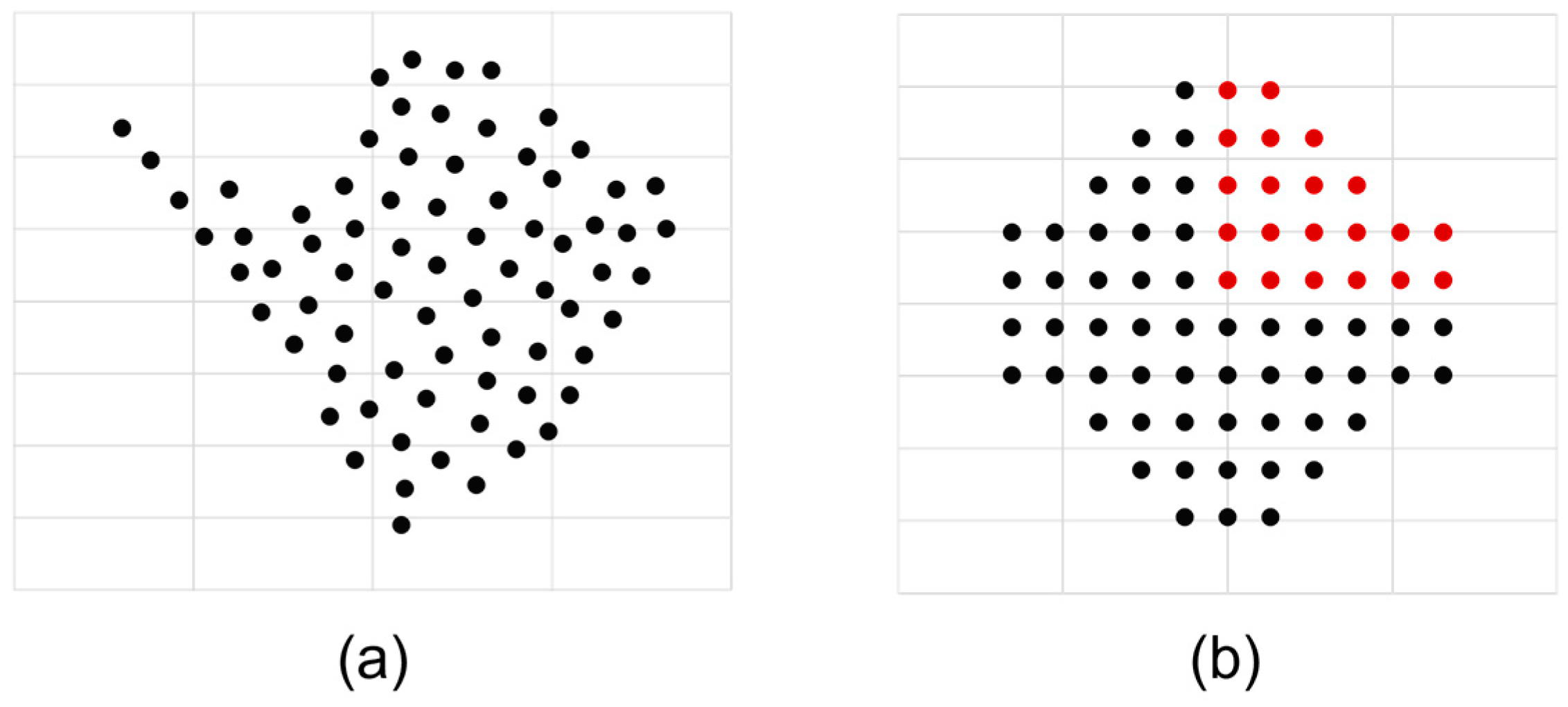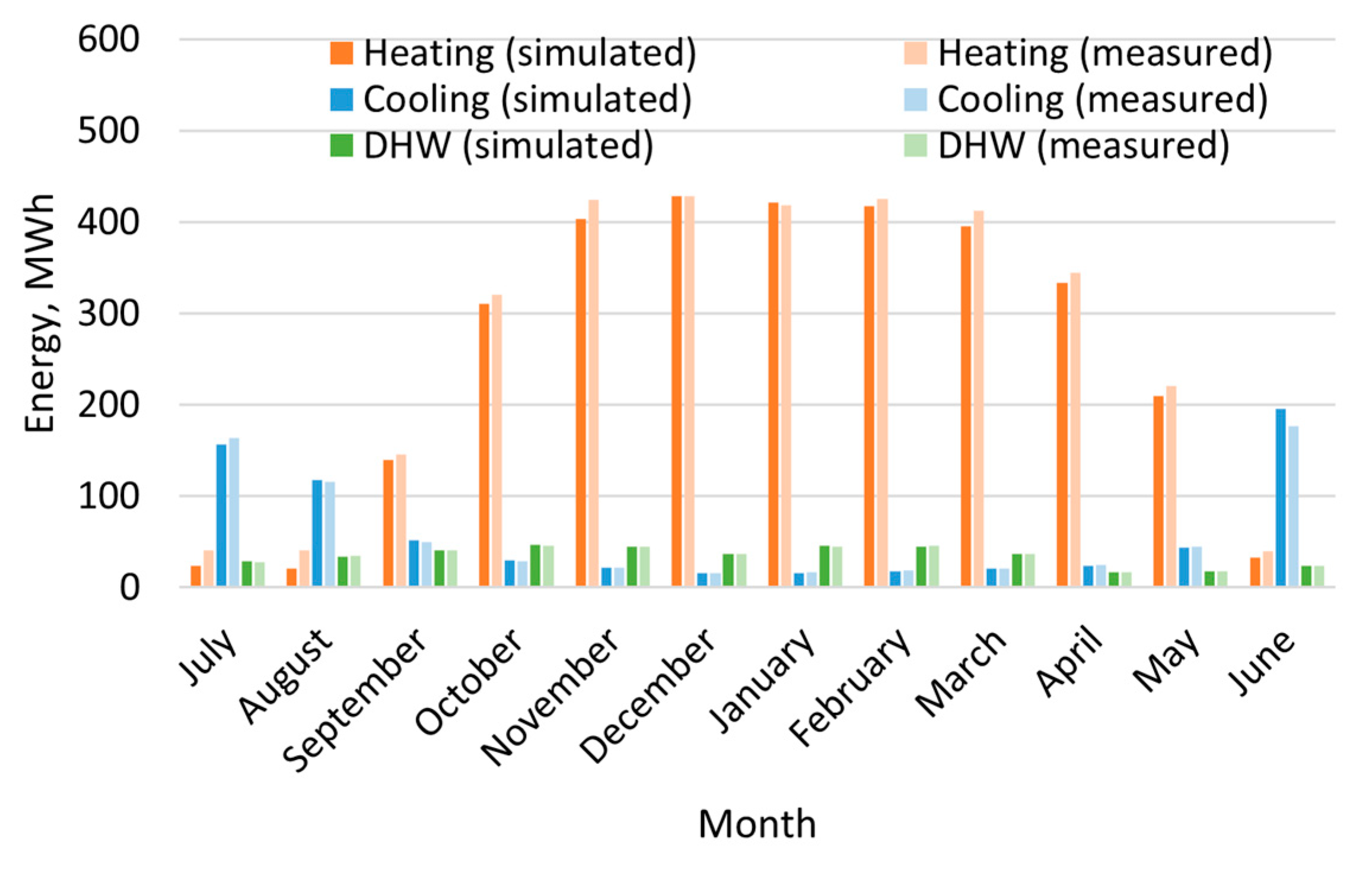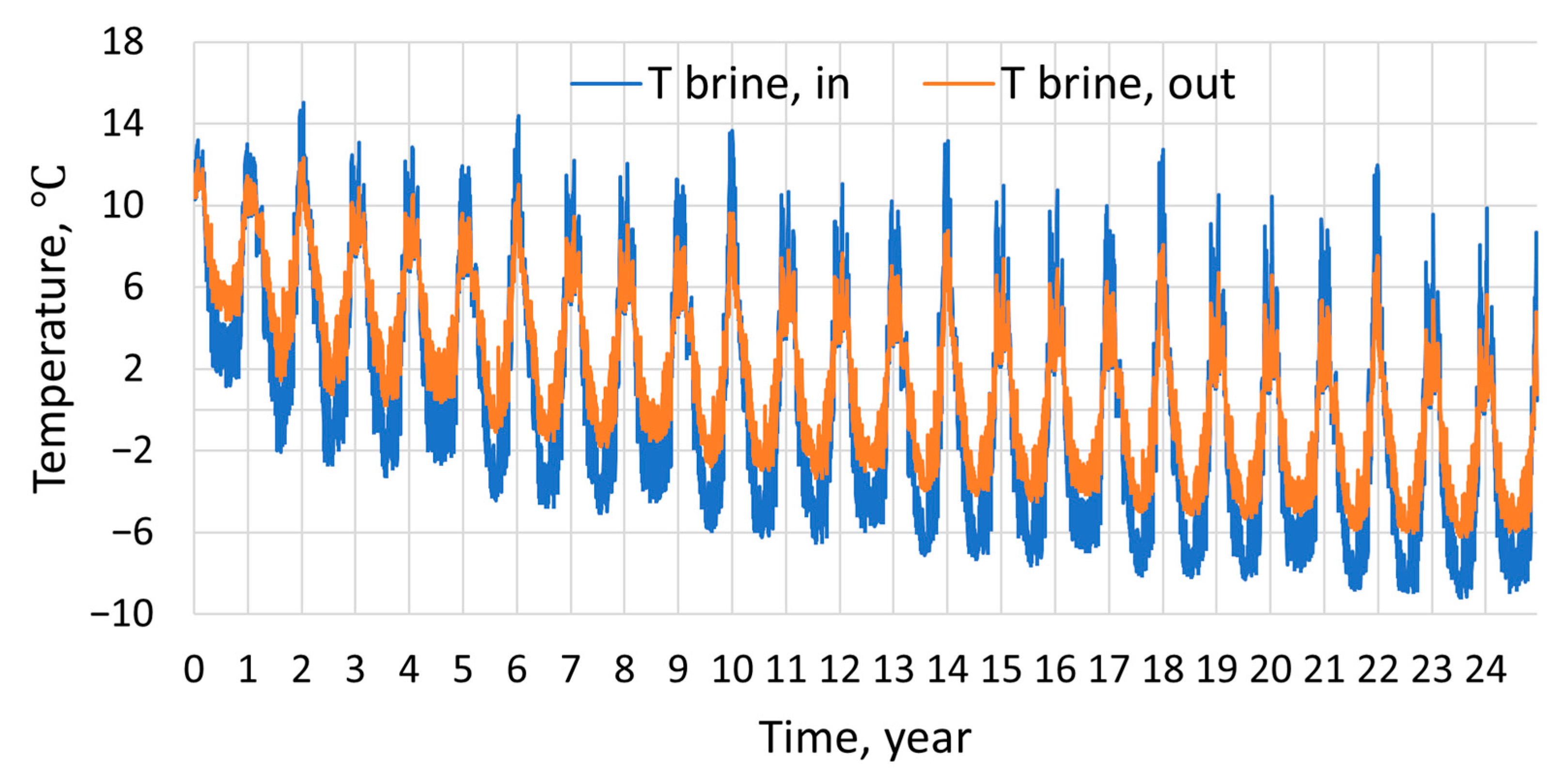1. Introduction
Buildings account for nearly one-third of global energy consumption and one-quarter of CO
2 emissions [
1]. In this context, improving energy efficiency and utilizing renewable energy technologies are major objectives in climate policies for buildings. One of the available renewable energy technologies is the ground source heat pump (GSHP) system. Over the last decade, GSHP systems have been prevalently used in many European countries for the reasons of high energy performance, reliability, environmental friendliness and easy integration with other energy systems [
2].
A GSHP system utilizes borehole heat exchangers to extract/inject heat from/into the ground for heating/cooling. In winter, since the brine outlet temperature is not able to be used directly, the borehole heat exchangers are coupled to the heat pump to raise the temperature for heating, while in summer, the heat pump process can be reversed to use the ground as a heat sink for cooling [
3]. However, it is also possible to use borehole heat exchangers directly for free cooling by means of high-temperature cooling terminal units, which can provide space cooling by using high-temperature chilled water [
4]. These free cooling systems are called direct ground cooling systems [
5,
6,
7] or borehole free cooling systems [
8,
9]. The borehole free cooling system is highly appealing due to its low energy consumption. It consumes considerably less electricity than the borehole-coupled GSHP system since it only requires operating circulation pumps in the brine loop. The energy efficiency ratio (EER) of the borehole free cooling system is commonly as high as 13–25 [
10]. Therefore, in regions with favorable climates and ground conditions, the joint utilization of active GSHP heating and borehole free cooling can be a highly efficient and profitable.
Sustainable long-term operation of the GSHP system requires the extracted heat for heating to equal the injected heat for cooling [
11]. This can guarantee that the ground annually restores its initial temperature. However, in regions with heating-dominant climates, the extracted heat far exceeds the injected heat, which can cause serious underground thermal imbalance during long-time operation. Many studies reported the underground thermal imbalance effect of GSHP systems in heating-dominant regions [
12,
13,
14,
15,
16]. Those studies have been summarized in the review work by You et al. [
17]. The review concluded the main critical problems caused by underground thermal imbalance, including brine and soil temperature changes, heating performance deterioration, heating reliability reduction and even system breakdown.
The brine and soil temperatures can drop significantly with the accumulated heat extraction. Kurevija et al. [
18] reported the soil temperature could even drop below 0 °C in heating months after 30 years, which means the soil moisture near the boreholes will freeze. When freezing occurs around the borehole heat exchangers, more complex analyses are required for the GSHP system. On the one hand, freezing soil could benefit the heat transfer efficiency of the boreholes due to the latent heat produced by phase change [
19,
20]. Yang et al. [
21] found this enhanced heat transfer could help reduce the borehole length and save on the investment cost. Zheng et al. [
22] reported that the outlet temperature of borehole heat exchangers increased by around 5 °C, and the coefficient of performance (COP) of the heat pump was improved by around 0.5, when freezing was considered. However, the moisture in the soil will expand during the freezing process. The volume expansion may cause pipe deformation and displacement [
23]. In Nordic countries, as the boreholes are commonly filled with groundwater instead of grout, the filled water can even start freezing when the brine temperature is below 0 °C [
24]. Therefore, avoiding freezing boreholes is critical for the design of GSHP systems in cold climates.
Applicable solutions are needed in the design phase of the GSHP system to tackle the underground thermal imbalance problem. The basic solution is to appropriately design borehole heat exchangers. You et al. [
17] summarized potential solutions in the design of borehole heat exchangers in cold regions. Those solutions include increasing the borehole spacing/number/length properly and modifying the borehole field layout with a larger aspect ratio. However, increasing the overall borehole length also results in a higher drilling cost. In addition, the borehole field design needs to consider the actual land use plan. Large borehole fields may not be feasible in dense cities with limited available land.
The actual borehole heat exchanger design commonly aims to find the minimum size of the borehole heat exchanger which can maintain a satisfactory performance of the GSHP system over the system lifespan. There are different design tools for sizing borehole heat exchangers. Spitler and Bernier [
25] classified these sizing tools into five levels (L0–L4) based on the resolution of time steps in the design methodology. The tools at higher levels generally require input building or ground loads in higher levels of time resolutions. L0 tools (rules of thumb) are mostly used for small system design with only heating purposes. They use a specific heat extraction rate (W/m) to calculate the total borehole heat exchanger length. Generic values of specific heat extraction rates have been used in certain countries. In Switzerland, Germany and Austria, 50–55 W/m is considered for borehole heat extraction [
26]. In Finland, this number is in the range of 30–45 W/m [
27]. However, L0 tools do not consider the borehole thermal interaction, which might lead to inadequate borehole heat exchanger length for large borehole fields. Therefore, they are more suitable for checking designs via more advanced sizing tools [
28], such as classic sizing equations from ASHRAE (L2 tool) [
29] and some commercial software programs like GLHEPro (L3 tool) [
30] and Earth Energy Designer (EED, L3 tool) [
31]. Although high-level sizing tools could improve the accuracy of predicted size requirements, they still require users to determine the input data accurately, especially the input of building or ground load, since it can influence the accuracy of the overall borehole length. Bernier and Dinse [
32] have revealed, in a specific case, that an uncertainty of 10% on the peak, monthly and annual ground loads can lead to an uncertainty of 8.9% on the overall borehole length. Therefore, using high-level sizing tools and estimating the input data accurately are both important for the designs of large borehole fields.
Even if the soil recovery ability can be maximized through the borehole heat exchanger design, it can be still difficult to eliminate the effect of underground thermal imbalance. Therefore, combining the GSHP with an auxiliary heating/cooling source is regarded as another applicable solution. In cold regions, auxiliary energy sources such as boilers, solar collectors and district heating can maintain the ground load balance and improve the GSHP performance [
33]. Xi et al. [
34] compared the long-term system performance of a hybrid GSHP assisted with solar heating with a conventional GSHP. The results presented that, after 20 years, the average soil temperature around the borehole heat exchangers was nearly the same as that in the first year, while the soil temperature dropped by 3.17 °C for the conventional GSHP. In addition, the system COP of the solar-assisted GSHP system was improved by 26.3% compared to the conventional GSHP. Liu et al. [
35] evaluated the performance and feasibility of a hybrid GSHP using a boiler as the supplementary heating source in the cold climate zone of China and compared it with a conventional GSHP. They found that after a 10-year operation, the soil temperature decreased by 0.9 °C and 7.7 °C for hybrid and conventional GSHP systems, respectively, which implied a more stable performance of the hybrid GSHP.
In addition to long-term system performance improvement, hybrid GSHP systems provide the potential to reduce the initial cost by shortening the overall borehole length and thus lower the system life cycle cost [
36]. Therefore, the heating power ratio of the GSHP and the auxiliary heating equipment is a critical parameter that must be well designed. Ni et al. [
37] conducted an economic analysis of a hybrid GSHP assisted by a gas boiler via numerical simulation. They found that when the heat pump meets a higher design heating load, the initial cost will increase, and the annual operational cost will decrease. Based on this, the optimum design heat load ratio of 60% for the GSHP can obtain the minimum present value of costs. Alavy et al. [
36] developed a generalized computational methodology to optimize the GSHP capacity for hybrid GSHP systems based on the minimum life cycle cost. The methodology was tested for ten buildings with different building types and heating and cooling load characteristics. The result showed among these buildings, the optimum capacity ratio of GSHP and the auxiliary energy source varied between 0.25 and 0.66. Nguyen et al. [
38] extended Alavy’s work to consider the effect of entering fluid temperature (EFT) to the heat pump into the design of hybrid GSHPs. They carried out the design optimization for ten buildings in Southern Ontario, Canada and compared the system’s CO
2 emissions. The results revealed when the design capacity ratio was optimized, using the optimum EFT pair for the heat pump can reduce the total cost by 3.6% compared to using a fixed EFT pair. However, to the best of our knowledge, there are limited studies comparing the solutions of adjusting design capacity ratio of GSHP and auxiliary heating device with modifying the overall borehole length in consideration of effects on energy performance, economy and environment.
Apart from appropriate designs of borehole heat exchangers and hybrid GSHP systems, there are also other solutions to mitigate the underground thermal imbalance. Those solutions include applying heat recovery to the GSHP, optimizing the ground load balance by adding borehole free cooling, optimizing the building load balance by changing the indoor air setpoint or optimizing the building envelope design. For instance, Javed et al. [
39] optimized the design of a GSHP system with a 25-year lifetime in a kindergarten building in Norway. They modified the building envelope characteristics to optimize the solar heat gains and thus reduced the ground thermal imbalance by over 37% compared to the base case. They even included the ventilation cooling load into the ground, which further reduced the imbalance ratio by around 54%. Zhai et al. [
40] applied two methods, including using heat recovery in air handling units (AHUs) and optimizing indoor air setpoints, to mitigate the underground thermal imbalance of a GSHP system in an archive building in Shanghai, China. The results revealed the discharging heat to the ground in the new system decreased by 33.7% compared to the system without heat recovery. In addition, higher indoor air setpoints can reduce the underground thermal imbalance and the soil temperature change after 15 years. Allaerts et al. [
41] optimized a GSHP system combined with floor heating, fan coils and a central AHU in a school building in Belgium based on 15-year simulations. They integrated an extra coil in the AHU which facilitates using waste heat from the exhaust ventilation air for heating the brine exiting the evaporator. In addition, they investigated the impacts of borehole free cooling in summer holidays on the annual energy balance. The results showed implementing heat recovery of the exhaust ventilation air with free cooling by boreholes can stabilize the ground temperature and save more energy. However, the aforementioned studies were only conducted for non-hybridized GSHPs. Zhai et al. [
40] only studied the effects of indoor air setpoints on non-hybridized GSHP long-term performance. Javed et al. [
39] and Allaerts et al. [
41] also only focused on enhancing borehole free cooling in non-hybridized GSHPs. In addition, they did not investigate the potential of enhancing borehole free cooling by increasing the AHU cooling water temperature level.
Therefore, despite the existing studies, there is still a research gap for investigating the solutions to improving long-term performance of hybrid GSHP systems. This research gap is summarized as follows:
Previous research has not investigated the effects of adjusting the AHU cooling water temperature level and modifying indoor heating and cooling setpoints on the long-term performance of hybrid GSHP systems.
According to the authors’ best knowledge, there are limited studies comparing the solutions of increasing borehole length with reducing the design heating power ratio of GSHP and auxiliary heating source for improving the long-term performance of hybrid GSHP systems.
The aim of this study is to investigate different methods for improving the long-term performance of a hybrid GSHP system and identify effective methods according to their effects on system energy consumption, life cycle costs and CO
2 emissions. The studied hybrid GSHP system was assisted by district heating and an air-cooled chiller in a large educational building. The investigation started with primary methods including increasing the AHU cooling water temperature level and lowering the indoor cooling and heating setpoints, and then it progressed to additional methods, such as reducing the nominal GSHP heating capacity and increasing the borehole number or borehole depth. This study was carried out based on the validated borehole field model from a previous study [
42]. The studied building and the hybrid GSHP system were both modeled and simulated in IDA Indoor Climate and Energy (IDA ICE) 4.8. and validated against the measured data. The results of this study can have a referential significance for the future design and control optimization of hybrid GSHP systems.
4. Discussion
According to the study, the outlet brine temperature in the reference case dropped far below the temperature limit of 0 °C for Nordic countries [
57]. It indicates the simulated borehole field was undersized for the GSHP in the reference case. The undersized dimensioning borehole field could be attributed to the misestimation of the heating power demand of the building, ground thermal properties or the groundwater level in the design phase [
24]. The undersized borehole field has been noticed by the building owner; some measures relating to improving the ground thermal balance have already been implemented in the actual building.
This study compared several cases using different performance improvement methods. In most studied cases, the brine temperature dropped below 0 °C, which means the groundwater in the borehole could freeze. In this study, the phase change process was not considered for the groundwater. This may lead to an underestimation of the brine temperature and the heat pump COP since freezing can bring advantages to the borehole heat transfer in practice. The freezing process will release significant latent heat. In addition, the already existing ice will enhance the borehole heat transfer as its thermal conductivity is nearly three times higher than that of water. And even though the convective flow in the water increases the heat transfer rate compared to the stagnant water, the ice still presents a generally higher heat transfer rate than the water in boreholes. The borehole thermal resistance of the entirely frozen borehole is around 20% lower than that of the borehole at 6 °C [
58].
However, the freezing process might cause damage to the pipes due to the volume expansion of water. The damage may happen only when the water is trapped between two ice blocks [
24]. If the water is stuck between two ice blocks and the borehole is watertight, the overpressure will happen while the water is freezing. The pressure will deform the U-pipe, reduce the brine mass flow rate, and thus degrade the GSHP performance. If the surrounding bedrock has fissures, they can drain the pressure water and lessen pipe damage. Nevertheless, additional measures are still needed to prevent the overpressure problem.
The easiest way is to avoid freezing in the borehole. Normally, in practice, the GSHP system is controlled to be shut down automatically when the outlet brine temperature is below the temperature limit. In the study, the optimal case can maintain the outlet brine temperature above 0 °C for 25 years, whereas the inlet brine temperature still dropped below 0 °C due to the temperature drop in the evaporator. This indicates the water can be still partly frozen in the borehole. To fully eliminate freezing in boreholes, the minimum temperature limit for the GSHP in heating mode could be increased to 2–3 °C. Apart from the GSHP control, additional measures on the borehole side could be implemented. These measures can be changing the filling of boreholes, blowing air into the borehole, adding air-filled soft tubes in the boreholes, using perforated casing, etc. [
24].
The study implemented lower indoor heating and cooling setpoints to mitigate the brine temperature drop and improve the heat pump COP. The cooling and heating setpoints were reduced from 25 °C to 22.5 °C and from 21.5 °C to 21 °C, respectively, in some studied cases. The variation of design heating and cooling setpoints could affect indoor thermal comfort. However, as the indoor temperature setpoints were in accord with the temperature limits given by the Finnish classification of indoor climate [
59], the change from the thermal environment was supposed to be in the comfortable range.
The study showed that increasing the total borehole length is more beneficial to mitigate the brine temperature drop compared to reducing the nominal GSHP heating power by the same proportion. The total borehole length was increased by adding extra boreholes or deepening the boreholes in this study. In the latter case, it was assumed that deeper boreholes are drilled in the initial drilling phase instead of obtained by deepening existing boreholes since some boreholes are under the building. In principle, the boreholes beneath the building are impossible to be extended. In addition, even though boreholes can be deepened, they might bring about uncertainty in the drilling cost. In this study, the additional drilling cost was assumed to be 20% of the original cost for the depth under 310 m based on the reference by Gehlin et al. [
57]. However, the actual drilling cost could vary according to the hardness of the rock. A harder rock requires changing the drill bit and increasing the energy used for drilling, which needs more additional cost. Therefore, compared to deeper boreholes, drilling more boreholes would be more viable in practice if there was enough space.
This study only investigated the ratio of 30% for reducing the GSHP heating power and increasing the total borehole length. This ratio can be further increased to obtain a more stable performance of the hybrid GSHP system. Further cost optimization work can even be performed to find the optimal design of the heat pump capacity and the total borehole length.
According to the analysis of CO
2 emissions, the case with a longer borehole depth revealed the minimum CO
2 emissions, while the case with reduced GSHP power showed a significant increase in CO
2 emissions. However, the result was unsurprising since the CO
2 emissions factor used for district heating (118 kgCO
2/MWh) was much higher than that for electricity (63 kgCO
2/MWh). The variation of CO
2 emissions factors can substantially impact the total CO
2 emissions. Currently, the decarbonization of electricity and district heating generation is ongoing in Finland to realize the carbon-neutral target by 2035 [
60]. A more detailed analysis of the hybrid GSHP system could be conducted from the aspect of different decarbonization scenarios in future work.
The weather data used for the 25-year simulation was developed based on the measured data from 2019 to 2021. As global warming occurs gradually, the studied building may have a lowering heating demand and an increasing cooling demand in the future [
61]. The variation of the heating and cooling demand may impact the result of long-term simulation for the hybrid GSHP system. Therefore, a deeper investigation is needed in the future for the design of hybrid GSHP systems in global warming scenarios.
5. Conclusions
A hybrid GSHP system combined with district heating and an air-cooled chiller was modelled and simulated in IDA ICE 4.8 to investigate the effective methods for improving the system long-term performance. Different methods, such as rising the AHU cooling water temperature level, lowering the indoor cooling and heating setpoints, reducing the nominal GSHP heating capacity and increasing the borehole number or borehole depth, were compared based on their effects on the system energy performance, life cycle cost and CO2 emissions.
The validation result showed the developed building and hybrid GSHP system models in IDA ICE 4.8 were eligible for simulations. The building model with simplified geometry and zoning can predict annual and monthly energy demands accurately. In addition, the hybrid GSHP system model can estimate the system performance with sufficient accuracy in the annual ground thermal imbalance ratio, average heat pump COP and GSHP heating energy ratio in the heating season and borehole free cooling energy ratio in the cooling season.
In the reference case, the brine temperature dropped significantly over time, resulting in a heating performance deterioration of the hybrid GSHP system. After the 25-year operation, the minimum outlet brine temperature in the heating season dropped from 4.4 °C to −6 °C, indicating a freezing risk of the borehole field. The average heat pump COP and the GSHP heating energy ratio in the heating season dropped by 9% and 5 percentage points, respectively, after 25 years. However, the decreasing brine temperature enhanced the borehole free cooling, which can cover 97% of the cooling energy demand in the last cooling season.
The freezing risk can be lowered by primary improving methods on the building side. In the case with a higher AHU cooling water temperature level and lower cooling and heating setpoints, the annual ground thermal imbalance ratio in the last year was reduced by 12 percentage points, and the minimum outlet brine temperature in the last heating season was increased by around 3 °C compared to the reference case. In addition, in the improved case, the average heat pump COP in the last heating season was increased by 3%, and the GSHP heating energy ratio in the last heating season was improved by 2 percentage points.
However, apart from adjusting the AHU cooling water temperature level and indoor heating and cooling setpoints, extra improving methods, such as reducing the GSHP power or increasing the total borehole length, were still needed for guaranteeing long-term operation. The result showed that increasing the total borehole length was more effective in maintaining the brine temperature level compared to reducing the GSHP capacity. The minimum outlet brine temperature can be increased to above 0 °C in the last heating season when the borehole depth was further increased by 30%.
The improving methods had an insignificant effect on the LCC of the hybrid GSHP system. The relative LCC differences between the improved and referenced cases were all within 2% in the two analyzed scenarios.
The CO2 emissions of the hybrid GSHP system were affected variously by different improving methods. By adjusting the AHU cooling water temperature level and indoor heating and cooling setpoints, the total CO2 emissions for 25 years were reduced by 3%. By further reducing the GSHP heating power or extending the borehole depth, the total CO2 emissions can be increased by 12% or reduced by 6% compared to the reference case.
